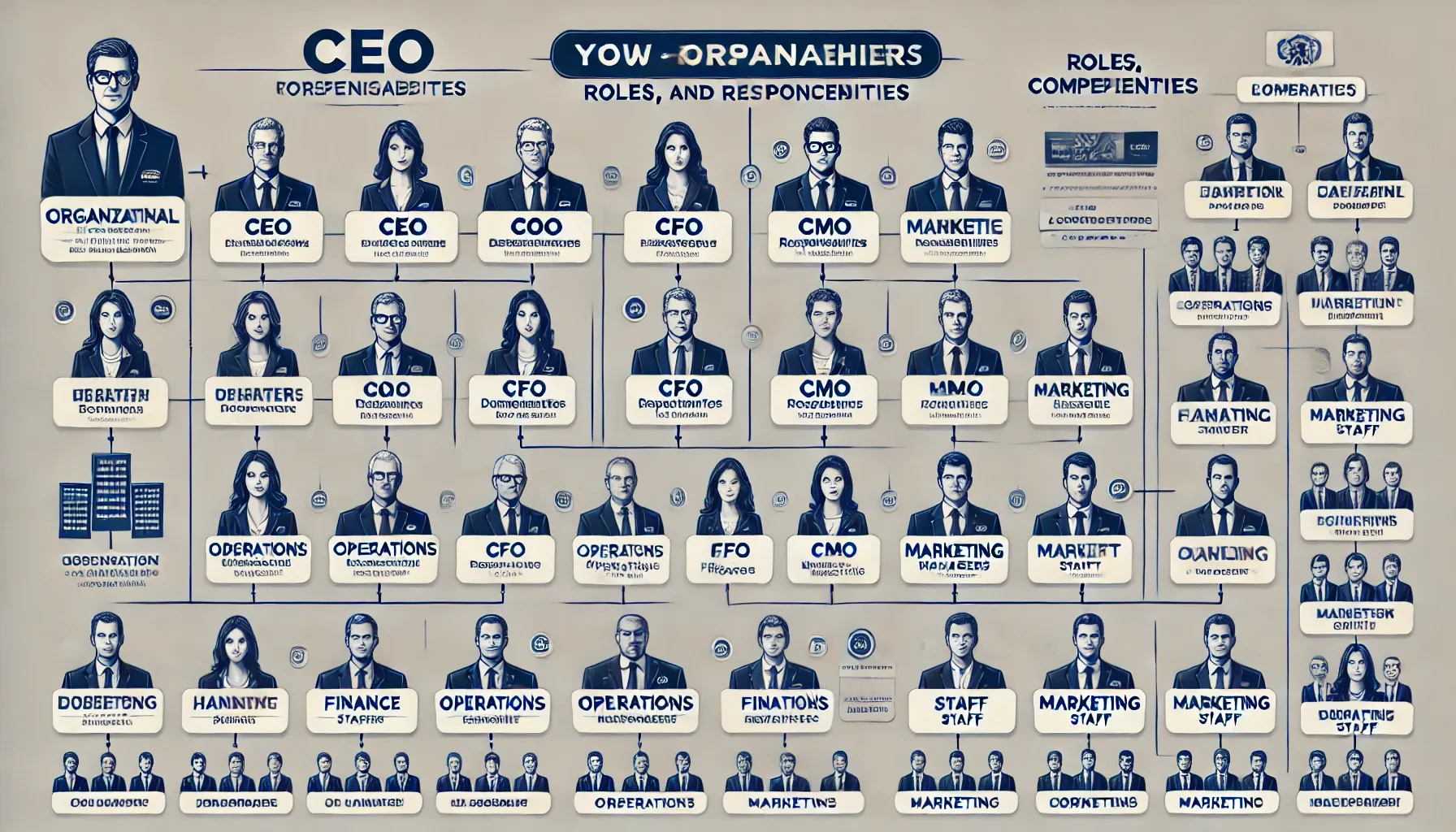Cultural Change Part One - The Business Model

Where do you start? With an organisational chart.
It will have fancy titles for those included, but how far do responsibilities go?
.....and what about competencies?
..... and who exactly in the organisation are represented?
I have to admit that sometimes I question the validity of organisational charts. Who are they for? Are they for external information, internal understanding or a mixture of both? Then, of course, there is the challenge of retaining good people and the effects that staff turnover has on running an organisation and changing those roles and people.
Once you have a nice shiny diagram, now comes the interesting bit. Ask every, and it has to be every, member of the team to note down what they do. This is their task list which may be daily, weekly, monthly or longer. Each task must not take more than a line to explain. No novels here please.
This is the extent to what Chatgpt 4.o sees as an example organisation chart:

What does this tell us? I think building an Organisational Chart is a starting point and a good discipline but I would hope it asks more questions than it answers. Most importantly, does this sufficiently represent how an organisation operates?
PwC taught me some amazingly insightful and pragmatic tactics. None more so than questioning where the actual power bases lie in any organisation and how to manoeuvre the levers of power to get change delivered.
We are not looking for a Soviet-style approach to business here. We are not looking to micro-manage your people, control operations through committee or implement a Sword of Damocles form of management. We need to see where tasks overlap, we can make savings there. We need to see where tasks can be automated, we can make savings there. We need to see where better tooling can be implemented, we can make savings there. We need to rationalise whether certain tasks should be undertaken, we can make savings there. We need to look if a business has changed in terms of income and costs over a time period.
As this process unfolds, we will undoubtedly encounter the tasks that have become part of a business's operations, but which are firmly routed in fire-fighting. This is simply where a business, quite often with an operational dysfunction, has taken steps to find a work around, to a problem without dealing with the problem itself. These challenges are usually compounded with higher levels of staff dissatisfaction, subsequent sickness and absenteeism, higher rates of staff turnover and questionable implementation of tooling. I have never come across an issue of fire-fighting which cannot be rectified with the right people using the right tools.
The best example of a fire-fighting business I have come across was on an epic scale. For me, it appeared to be an industry-wide issue. Over the last ten years, amplified over the Lockdown years, the amount of home deliveries have dramatically increased. We all do it. As a result, the shear numbers of lost in transit items generated by the huge national couriers has exploded. For many of us, how any parcel could get lost seems ridiculous. However, from my own personal experience I have witnessed millions of lost parcels, worth millions of pounds being offloaded to the market via public auction. The couriers simply did not have the infrastructure in place to store, audit and return lost parcels to their owners. As such, they all had no choice but to sell the items via public auction, in a transparent market. The solution was never to do this. The solution is not to lose these parcels. Invest in tools and people and audit processes which can deliver this business need. The irony here, is that they outsourced their business dysfunction to a third party.
Then ask them to note the most important people that help them get their tasks done on time. Footnotes not required! However encourage inclusion of third parties or people not directly employed by the organisation.
Then ask them to list which tools they use to deliver their tasks. Order in terms of ‘most use’.
Finally in less than 50 words ask them to highlight where they have looked to deliver their tasks differently in the last year.
The vast majority of your team will feel overworked, with similar proportion explaining that only more resource, normally more people, will help with efficiency. There could be low moral. All of these issues can be dealt with by good, professional leadership.
Now let’s focus on leadership. Good leadership is about enabling your team to reach the requirements of the business. It is not about revelling in fighting fires. Getting things done can simultaneously be strategic, pragmatic and magic!
The first thing to ask of your leaders is to write an elevator pitch for their organisation. Where do they get money from? What do they offer? Where is the value added?
Here's two I did earlier:
Declutter, downsize, probate or side hussle. Deal with life's stuff by generously freecycling, making some money, doing a swap or renting your time. Do the deal through secure messaging. Scam free. It's like Classified Adverts by WhatsApp.
Simplify Probate. Pass on what truly matters to your loved ones.
We will be talking about the two cornerstones of good management, delegation and team work, in Part Two of this blog. We will also be looking at taking responsibility and transparency within an organisation. At this point, we need to be gathering information, building a true picture of where we are with a view to drawing up a series of judgements. This can only be done in tandem with a series of pragmatic solutions to deal with every issue.
Naturally the questions over people competencies will be asked. You may well find that people have been promoted above their abilities, however what training and support has the business offered them?
As with all things in business, you can overcomplicate this process. It does not matter if you are looking at a small business or large corporation, the principles remain exactly the same. You will find that certain members of your team will overcomplicate what you ask of them. This could be to do with a lack of understanding of why change is taking place, a lack of ability or that they have their own agenda. Either way, change is good, and with the new opportunities presenting themselves through AI tools, organisations need to be on their toes.
There is an elephant in the room. This is the will, the desire, to enable positive change. This needs to come from the top.
Your people may well believe that this is well above their pay grade or have developed static working practises over years in the job. Your middle management may well believe they are senior management, but lack the ability or credibility to introduce change. Dealing with change is all about leadership.
On a final note, undertaking these foundation steps at looking at change are not simply never to be done again. Undertake these reviews regularly. Your organisation and the wider business landscape are changing quicker than your may want to accept.







